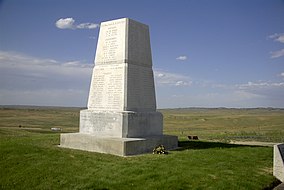Memorials
The first memorial on the site was assembled by Captain George K. Sanderson and the 11th Infantry. They buried soldiers' bodies where they were found and removed animal bones. In his official report dated April 7, 1879, Sanderson wrote:
I accordingly built a mound out of cord wood filled in the center with all the horse bones I could find on the field. In the center of the mound I dug a grave and interred all the human bones that could be found, in all, parts of four or five different bodies. This grave was then built up with wood for four feet above ground. The mound is ten feet square and about eleven feet high; is built on the highest point immediately in rear of where Gen'l Custer's body was found ...
Lieutenant Charles F. Roe and the 2nd Cavalry built the granite memorial in July 1881 that stands today on the top of Last Stand Hill. They also reinterred soldiers' remains near the new memorial, but left stakes in the ground to mark where they had fallen. In 1890 these stakes were replaced with marble markers.
The bill that changed the name of the national monument also called for an "Indian Memorial" to be built near Last Stand Hill.
Markers honoring the Indians who fought at Little Big Horn, including Crazy Horse, have been added to those of the U.S. troops. On Memorial Day, 1999, the first of five red granite markers denoting where warriors fell during the battle were placed on the battlefield for Cheyenne warriors Lame White Man and Noisy Walking.
The Indian Memorial (2001–2003) was designed by John R. Collins and Alison J. Towers, who won a national competition in 1997 set out by Congress. Constructed of sandstone, it takes the form of a circular low wall that is topped with sculptor Colleen Cutschall (Oglala and Sicangu)'s bronze figure procession Spirit Warriors. [8] Then-Colorado Senator Ben Nighthorse Campbell spoke at the dedication of the monument: "[...] Come back sometime early in the morning after a rain when the fog is laying in the valleys and things are quiet and the moon is waning, and perhaps all you can hear is the sounds of nature. If you're here by yourself during that time, I know you'll feel like Indian people feel when they're here." Nighthorse Campbell is descended from one of the Cheyenne leaders who fought General Custer. [9]
The warriors' red speckled granite memorial markers dot the ravines and hillsides, just as do the white marble markers representing where soldiers fell. Since then, markers have been added for the Sans Arc Lakota warrior Long Road and the Minniconjou Lakota Dog's Back Bone.
On June 25, 2003, an "unknown Lakota warrior marker" was placed on Wooden Leg Hill, east of Last Stand Hill to honor a warrior who was killed during the battle, as witnessed and reported by the Northern Cheyenne warrior Wooden Leg.
The battlefield is the final resting place of the western historian and author Stanley Vestal, a professor at the University of Oklahoma.
This page is based on this
Wikipedia article Text is available under the
CC BY-SA 4.0 license; additional terms may apply.
Images, videos and audio are available under their respective licenses.










